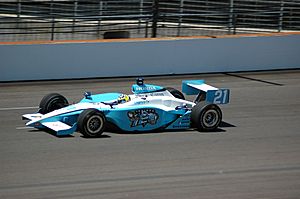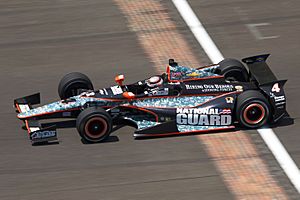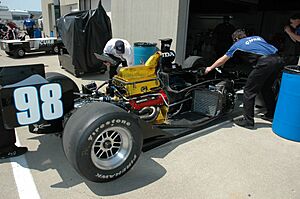IndyCar Series facts for kids
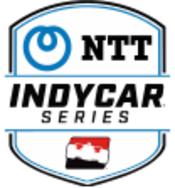
Logo used since 2019
|
|
| Category | Open-wheel racing |
|---|---|
| Region |
|
| Inaugural season | 1996 |
| Drivers | 33 (including part-time drivers running only in the Indianapolis 500 and other select races) |
| Teams | 12 (including part-time teams running only in the Indianapolis 500 and other select races) |
| Chassis suppliers | Dallara |
| Engine manufacturers |
|
| Tire suppliers | Firestone (Bridgestone) |
| Drivers' champion | |
| Makes' champion | Chevrolet |
The IndyCar Series, also known as the NTT IndyCar Series for its main sponsor, is the top level of American open-wheel car racing in the United States. This type of racing uses special cars with open wheels, meaning the wheels are outside the car's body. The series started in 1996 as the Indy Racing League (IRL). It was created by Tony George, who owned the Indianapolis Motor Speedway. He wanted to compete with another racing series called CART.
In 2008, the IndyCar Series and CART's newer version, the Champ Car World Series, joined together. This brought all their history and records into one series. The most famous race in the series is the Indianapolis 500, which first happened way back in 1911. Open-wheel racing used to be very popular in America. However, a big disagreement in 1994 between CART and Tony George led to the creation of the Indy Racing League. This caused the sport's popularity to drop a lot. Even after the two series merged in 2008, it took time for the sport to recover. Today, IndyCar continues to grow its viewership each year.
Contents
- About the IndyCar Series
- IndyCar Race Cars
- Race Tracks
- Teams in IndyCar
- How Points are Scored
- Championship Seasons
- IndyCar Statistics
- Watching IndyCar Races
- IndyCar Logos
- See also
About the IndyCar Series
What's in a Name?
When the series first started in 1996 and 1997, it was simply called the Indy Racing League. From 1998 to 1999, it got its first main sponsor and was known as the Pep Boys Indy Racing League. In 2000, an internet company called Northern Light became the sponsor, and the series was named the Indy Racing Northern Light Series.
The name IndyCar Series was officially adopted in 2003. This happened because a legal agreement with CART from 1996 had ended, allowing the series to use the name. Over time, the old "IRL" name was used less and less. By 2008, the series was just called IndyCar. The company itself also changed its name to IndyCar in 2011.
Big companies have sponsored the series over the years. Izod was the title sponsor from 2009 to 2013. Then, Verizon Communications took over from 2014 to 2018. In 2019, NTT, a Japanese communications company, became the main sponsor. NTT extended their sponsorship in 2023, showing their continued support for IndyCar.
IndyCar Race Cars
IndyCar Series cars are special. While all teams use the same main car body (chassis), different companies can make the engines. Currently, Dallara builds the chassis for all teams. Honda and Chevrolet provide the different engines.
Car Body (Chassis) History
Early Years (1996–2011)
In the very first season in 1996, older car bodies from 1992-1995 CART races were used. The first new IndyCar chassis appeared in 1997. Tony George wanted new rules for cars that were less expensive and used engines based on production models. This meant the older CART chassis and powerful turbocharged engines, which had been common at the Indianapolis 500, were no longer allowed.
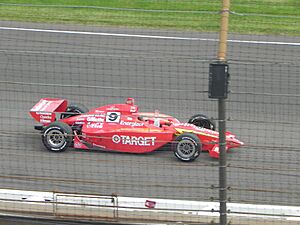
From 2003, the series required car body makers to be approved by the league. Before that, anyone could build a car if it followed the rules and was sold at a set price. Four different companies have built IndyCar chassis.
Dallara started making IndyCars in 1997. At first, Dallara and G Force chassis were pretty equal. But soon, Dallara cars started winning more races. This led more teams to choose Dallara, making them even more successful. As of 2017, Dallara chassis had been used by 17 Indy 500 winners. Since 2008, Dallara has been the only company supplying new chassis.
The G Force chassis was introduced in 1997 and won the Indy 500 in 1997 and 2000. In 2002, another company bought G Force, and the chassis was renamed "Panoz G Force," then just "Panoz" in 2005. A new Panoz model came out in 2003 and won the Indy 500 in 2003 and 2004. However, it became less popular after 2006.
Riley & Scott also made IndyCar chassis from 1997 to 2000. Their first car was not very competitive. After Riley & Scott was bought by another company, a new model was introduced in 2000. It won one race but was quickly dropped by teams.
Falcon Cars was a company that planned to supply chassis in 2003, but their car never actually raced. IndyCar machines look a lot like other open-wheel race cars, with front and rear wings. They were first designed mainly for oval racing, with some parts made to handle the forces of turning left all the time. Later, they were changed to work well on road courses too.
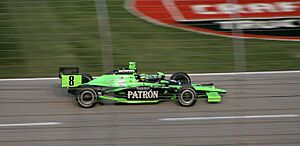
New Chassis Era (2012–2014)
In 2010, IndyCar decided that all teams would use the same chassis starting in 2012. They created a committee to choose the best design. Several companies submitted ideas, including a unique DeltaWing design.
In July 2010, Dallara won the contract to continue as the only chassis supplier. In 2012, the series started using the Dallara IR-12 chassis to help control costs. This new car also had improved safety features, like a partial cover around the rear wheels to prevent cars from climbing over each other. This chassis was meant to allow different aerodynamic kits, but these were delayed until 2015 due to costs.
After a sad event at the 2011 season finale, the chassis was nicknamed DW12 in honor of driver Dan Wheldon.
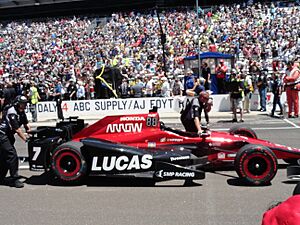
Aero Kits and Universal Bodywork (2015–Present)
In 2015, teams began using special aerodynamic kits made by their engine manufacturers. These kits changed how the cars looked and performed, making them faster and giving each manufacturer a unique look. However, they also made racing much more expensive. Chevrolet's aero kit was often better, with Honda only being competitive on oval tracks due to slightly more engine power. After two years, the aero kits were frozen for 2017, and starting in 2018, all cars used the same aero package again to save money.
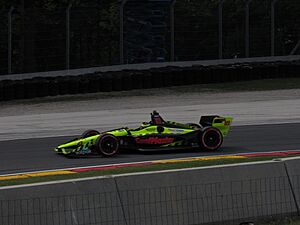
The 2017 season was the last year for the special Chevrolet and Honda aero kits. From 2018, all DW12 chassis were fitted with a new, universal bodywork kit. This new car, called the 'IR18', was designed to look more like the CART cars from the 1990s and 2000s, with a smoother shape. This new kit reduced how much downforce the cars had and lowered development costs for teams. It also had fewer small parts that could break off, which meant less debris on the track.
For the 2020 season, a new safety feature called the "aeroscreen" was added. This system combines a "Halo" (a protective bar above the driver's head) with a reinforced windscreen. It helps protect drivers from flying debris and serious head injuries. Some small changes were made later to help reduce the heat inside the cockpit for drivers.
Future Plans for the Chassis
Discussions about replacing the Dallara DW12 chassis began in March 2024. The DW12 had been updated in 2018, and most open-wheel series replace their cars every five years or so. Dallara will continue to be the official chassis builder for the next generation of cars, known as the IR-27 era.
In December 2024, IndyCar announced that they would start testing a brand-new Dallara IR-27 chassis. This new car is expected to debut in the 2027 season. Its design will be based on Formula One car aerodynamics from 2022 and 2026. It will not have an airbox above the cockpit, similar to current cars. It will also feature an aggressive aerodynamic package for road and street courses to make overtaking easier. The IR-27 chassis will use larger 18-inch wheels, like those in Formula One and NASCAR, and new low-profile Firestone tires. It is also likely to use a Formula 1-style drag reduction system (DRS) on road and street courses, but not on oval tracks because it's considered too dangerous there.
On June 12, 2025, it was announced that the new chassis would be delayed until 2028 and renamed the Dallara IR-28.
Gearbox and Clutch
IndyCar Series cars use a special 6-speed semi-automatic gearbox. Drivers change gears using paddles on the steering wheel. The clutch is only needed to start the car from a stop; drivers don't need to use it for shifting gears. These parts have been supplied by Xtrac Limited since 2008. Before that, drivers used a hand-shifted lever. The clutches are made of carbon and are supplied by AP Racing. All IndyCars are rear-wheel drive, meaning the engine powers the back wheels.
Brakes
From 1996 to 2011, IndyCar Series cars used thinner carbon brake rotors with 4-piston calipers and carbon pads for oval races. For road and street courses, thicker steel brake rotors with 6-piston calipers were added in 2005 to provide stronger braking for sharp turns. Since 2012, IndyCar Series cars use carbon brake rotors on all types of tracks, but the caliper setup remained similar to the earlier years.
PFC has supplied the brake parts for all IndyCar Series cars since 2017. Before that, Brembo supplied brakes from 2012 to 2016, and Alcon from 2003 to 2011.
Wheels and Tires
BBS and O.Z. Racing have supplied the wheels since 1996. The wheels are made of aluminum alloy. Since 1996, the front wheels have been 10 inches wide and 15 inches in diameter, and the rear wheels 14 inches wide and 15 inches in diameter. These sizes will be used until at least the 2022 season. Larger 18-inch wheels will be used when the new chassis comes out.
Firestone has been the tire supplier for the series since 1996 and the only supplier since 2000. Goodyear also supplied tires from 1996 to 1999. IndyCar uses special tires designed for different conditions. For road and street races, there are different tires for dry conditions and special rain tires. For oval racing, a single type of tire is used, with the right rear tire being slightly larger than the left rear. This "stagger" helps the car turn better at high speeds on ovals.
Suspension
The suspension system on all IndyCar Series cars uses a double A-arm design with pushrods, a third spring, and an anti-roll bar. This setup helps the car handle bumps and turns smoothly.
Cockpit and Safety

All NTT IndyCar Series cars have carbon-fiber driver's seats with 6-point safety belts. The steering wheels, designed by Cosworth, have buttons that let drivers adjust their cars during a race. From 2001 to 2017, cars used Pi Research Sigma Wheels to show data. Since 2018, Cosworth's Configurable Display Unit 4.3 has been used, though some smaller teams still used the older Pi Research wheels in 2018 to save money.
The cockpits of all IndyCar Series cars are open but have protection made of zylon, a strong material, along with foot protection and padding.
As mentioned, starting in 2020, IndyCar added a cockpit protection system. This includes a "Halo" and a reinforced windscreen called the "aeroscreen," provided by Red Bull Advanced Technologies. This system helps protect drivers from head injuries caused by flying debris.
Other Car Parts
All IndyCar Series cars have an Electronic Control Unit (ECU). This unit controls the engine. Live data from the ECU is used for TV broadcasts. When the car is in the garage, data can be downloaded to a computer. McLaren has supplied the standard ECU system since 2010.
Rearview mirrors are required on all IndyCar Series cars.
Fuel
Early Fuels (Methanol and Ethanol)
When the IRL started, it used methanol racing fuel. This had been the standard in American open-wheel racing since a crash in 1964. Methanol is safer than gasoline because it has a higher flash point and can be put out with water. However, it burns with an invisible flame. For night races, special mixtures were added to the fuel to make the flame visible as a light blue haze.
In 2005, the driver Paul Dana brought sponsorship from the Ethanol Promotion and Information Council (EPIC) to his team. EPIC wanted to show that ethanol was a good fuel and didn't damage engines. Sponsoring an IndyCar was a way to promote ethanol.
Dana passed away in a crash in 2006, but IndyCar had already started switching to ethanol fuel. For the 2006 season, the fuel was a mix of 90% methanol and 10% ethanol. Starting in 2007, the league used "100% Fuel Grade Ethanol," becoming the first racing series to use renewable fuel. This mixture was actually 98% ethanol and 2% gasoline. The gasoline was added to make the alcohol unfit for drinking and to add visible color in case of fire. However, at the 2010 São Paulo Indy 300 in Brazil, a full E100 mixture was used.
To make up for the power loss from using ethanol, the engine size was increased. Since ethanol uses less fuel than methanol, the fuel tank size was made smaller.
Compared to methanol, ethanol is much less harsh if it touches skin, and its fumes are less irritating. The fumes are often said to smell like apple cider. Ethanol is also less polluting if spilled.
In May 2010, Sunoco became the official fuel supplier until 2018. For the 2012 season, the ethanol blend was reduced to 85% to be more like fuels used in regular cars. Speedway LLC took over as the official fuel supplier in 2019, keeping the E85 formula until 2022.
From 2023, Shell USA started supplying 100% ethanol-sourced fuel, a first since 2011.
Fuel Tank
The fuel tanks in all current IndyCar Series cars are made of rubber and covered with a Kevlar blanket for extra protection in crashes. Since 2012, the tanks hold 18.5 US gallons (70 liters) of fuel. Earlier tanks held more, like 22 US gallons (83 liters) from 2007 to 2011.
Engines
First Engines (1996)
In the first 1996 IRL season, cars used engines that were similar to those from the rival CART series. These engines were V-8s with a certain amount of boost. The Menard-Buick V6 engine used in 1996 was an updated version from 1995. It was allowed more boost than other engines.
Ford-Cosworth and Ilmor Mercedes V-8 engines were also allowed.
Second Generation Engines (1997–2011)
Starting in 1997, IRL cars used 4.0-liter V8 engines. These engines ran on methanol fuel and produced around 600-700 horsepower. They were designed for racing but were based on production models.
The engine rules changed in 2000. The engine size was reduced to 3.5 liters, and the requirement for the engine block to be production-based was removed. These engines made 675 horsepower and ran on 109-octane methanol fuel. In 2004, after some serious crashes, the engine size was reduced again to 3.0 liters to lower top speeds.
Infiniti's engines were reliable but less powerful than Oldsmobile's in 1997. Many teams switched away from Infiniti. By 2000, Infiniti's engine had improved and won a race, but few teams used it, and the company left the series after 2002.
As General Motors stopped making Oldsmobile cars, the Olds engine was renamed Chevrolet in 2002. However, it struggled against engines from Toyota and Honda, which joined the IRL in 2003. Chevrolet announced in 2004 that it would stop its engine program after the 2005 season due to high costs.
Toyota won its first race in 2003, as well as the Indianapolis 500 and the series title. But by 2005, Honda became the main engine supplier. In November 2005, Toyota also announced it would leave American open-wheel racing to focus on NASCAR.
Honda as the Only Engine Supplier (2006–2011)
After Chevrolet and Toyota left, Honda became the only engine manufacturer in the IndyCar Series from 2006 to 2011. Since Honda had no rivals, they focused on making engines reliable and affordable instead of making them super powerful. These engines were very durable; there were no engine failures at Indy from 2006 to 2010. Most engines were used for multiple races and were designed to last for 1,200 miles (1,900 km) between rebuilds. Teams leased the engines from Honda.
IndyCar Series engines were limited to 10,300 revolutions per minute (rpm) and produced about 650 horsepower. A "push-to-pass" system was added in 2009, which temporarily increased the engine's power to 690 horsepower. In 2009, Honda stopped developing the Indy V8 engine to focus on a new V6 turbo engine for the 2012 season.
Third Generation Engines (2012–Present)
The current, third-generation IndyCar engine was introduced in 2012. This brought back engine competition with two new manufacturers. The engines are now fuel-efficient 2.2-liter twin-turbo V6 engines. They produce an estimated 550–750 horsepower, depending on the boost level, and are limited to 12,000 rpm. They weigh at least 248 pounds (112 kg). Chevrolet and Honda currently supply these engines.
McLaren has supplied the engine control unit since 2012. The fuel injection system now uses both direct and electronic indirect injection. Chevrolet returned to the series in 2012 with new V6 twin-turbocharged engines. Honda also stayed, initially with single-turbocharged engines, but switched to twin-turbochargers from 2014 onwards. Lotus also provided an engine in 2012 but left in 2013 because their engine was not competitive.
The electric push-to-pass system was brought back in 2012. This system provides about 60 horsepower for a short time, from 6 to 200 seconds, depending on the track. It can be recharged during the race. Porsche showed interest in joining as an engine supplier in 2019 but decided not to when IndyCar wouldn't allow hybrid powertrains at the time. Coincidentally, IndyCar announced plans for hybrid powertrains a month later.
From the 2024 season, hybrid systems will be introduced. These systems will recover energy from the car's braking and use it to boost power.
Turbocharger
Turbochargers were brought back to IndyCar in 2012. Since 2014, cars use a twin-turbo setup. The American company BorgWarner is the only supplier of turbocharger kits. All cars since 2014 use the EFR7163 model to save costs. IndyCar Series cars do not use intercoolers, which are usually found with turbos, to save weight. Ethanol fuel burns at lower temperatures, which helps keep the engine cool without an intercooler.
Spark Plugs
Bosch (for Chevrolet) and NGK (for Honda) have provided spark plugs for all IndyCar Series cars since 2012. NGK was the only supplier from 2006 to 2011 when Honda was the sole engine supplier.
Performance
Current IndyCar Series cars can reach speeds of about 235–240 mph (378–386 km/h) on the Indianapolis Motor Speedway oval. On other intermediate and long ovals, top speeds are around 215–220 mph (346–354 km/h). On road courses, street circuits, and short ovals, speeds are about 200–210 mph (320–340 km/h), depending on how the car's downforce is set up.
Race Tracks
After the split from the IndyCar World Series, the Indy Racing League started as a series that only raced on oval tracks. Besides the famous Indy 500, races were held at 1-mile ovals like Phoenix and Loudon. A new track was also built at Walt Disney World in Florida, where the first IRL race took place in January 1996.
Over time, IndyCar started racing on ovals mainly used by NASCAR, like those in Las Vegas and Fort Worth. However, after some big accidents and low attendance, tracks like Charlotte, Atlanta, and Las Vegas were removed from the schedule. For the 2001 season, the IRL also began racing on ovals that CART used to visit, such as Homestead and Gateway. New 1.5-mile ovals in Kansas, Kentucky, and Chicagoland were added, becoming key tracks until 2011.
A big change happened in the 2005 season. For the first time, the IRL held races on road and street courses. A street race in St. Petersburg was added, along with races at Sonoma and Watkins Glen. In 2007, the Mid-Ohio Sports Car Course was added. When the Champ Car World Series ended in 2008, IndyCar took over some of their races, including street races in Long Beach, Detroit, and Toronto, and later Road America in 2016. A road course race at Barber Motorsports Park and an oval race at Iowa Speedway were also added.
Another major change occurred in the 2012 season. In 2011, the series returned to Las Vegas Motor Speedway. The track had been rebuilt, leading to very close "pack racing." A large crash happened on lap 11, injuring several drivers and sadly resulting in the death of Dan Wheldon. This event led to much criticism of oval races for open-wheel cars. As a result, and due to declining attendance, most 1.5-mile oval races were removed from the calendar, except for Texas Motor Speedway. Only the oval races in Indianapolis, Milwaukee, Iowa, Texas, and Fontana remained for the next three seasons. Instead, more races were held in cities like Houston, Baltimore, and São Paulo.
In recent years, the calendar has become more stable. Races returned to Phoenix, Pocono, and Gateway, though some, like Fontana, Pocono, Phoenix, and Milwaukee, were later removed due to low crowds or serious crashes, including the fatal crash of Justin Wilson at Pocono in 2015.
Since 2012, the IndyCar calendar has generally been split into about one-third oval races, one-third races on permanent road courses, and one-third races on temporary street courses in big cities. In 2019, IndyCar raced for the first time on a current Formula 1 track, the Circuit of the Americas in Austin, Texas.
Due to the COVID-19 pandemic in 2020, many races were affected. For the first time since 1911, the Indianapolis 500 was not held on its usual date. Traditional street races in Long Beach, Detroit, and Toronto were canceled. To make up for this, some tracks like Road America, Iowa, Mid-Ohio, and Gateway held "double-header" races (two races on the same weekend).
Texas Motor Speedway was removed from the schedule for the 2024 season because the series and track couldn't agree on a date. However, in October 2024, it was confirmed that the IndyCar Series would return to North Texas for the Grand Prix of Arlington in March 2026. This new 2.73-mile track will be built around AT&T Stadium and Globe Life Field.
Teams in IndyCar
| Team | Manufacturer | Base | Founding year |
|---|---|---|---|
| A. J. Foyt Enterprises | Chevrolet | Speedway, Indiana | 1965 |
| Andretti Global | Honda | Indianapolis, Indiana | 1993 |
| Arrow McLaren | Chevrolet | Indianapolis, Indiana | 2001 |
| Chip Ganassi Racing | Honda | Indianapolis, Indiana | 1990 |
| Dale Coyne Racing | Honda | Plainfield, Illinois | 1984 |
| Ed Carpenter Racing | Chevrolet | Indianapolis, Indiana | 2012 |
| Juncos Hollinger Racing | Chevrolet | Indianapolis, Indiana | 1997 |
| Meyer Shank Racing | Honda | Pataskala, Ohio | 1989 |
| Rahal Letterman Lanigan Racing | Honda | Zionsville, Indiana | 1991 |
| Team Penske | Chevrolet | Mooresville, North Carolina | 1968 |
| Prema Racing | Chevrolet | Grisignano di Zocco, Veneto, Italy | 2025 |
How Points are Scored
IndyCar gives points to drivers based on where they finish in a race. The winner gets 50 points. The top four drivers get 50, 40, 35, and 32 points respectively. Drivers from fourth to tenth place get two points less than the driver ahead of them. From eleventh to twenty-fifth place, drivers get one point less than the driver ahead. All other drivers who start the race get five points.
Bonus points are also given:
- One point for the driver who gets the pole position (fastest qualifier) in each race (except at Indianapolis).
- One point for any driver who leads at least one lap in a race.
- Two extra bonus points for the driver who leads the most laps in a race.
For the Indianapolis 500, qualifying points are awarded to all 33 cars. The points are given based on how fast teams qualify, with more points for those who make it into the top-nine shootout.
From 2014 to 2022, the Indianapolis 500 awarded double points for all finishing positions. Starting in 2023, drivers earn the same points as any other race.
If there's a tie in points at the end of the season, the champion is decided by who has the most first-place finishes. If it's still a tie, they look at who has the most second-place finishes, then third, and so on, until a champion is found. This same system is used for any other ties in the rankings during the season.
Championship Seasons
The table below lists the champions since the current series began. However, it's important to know that championships from before this period are also counted as part of one continuous championship. This happened after the merger of CART/Champ Car into the Indy Racing League in 2008, when the IRL gained all the historical records going back to 1909.
| Season | Drivers' Champion | Engine Manufacturers' Champion |
Rookie of the Year | Most Popular Driver | |||
|---|---|---|---|---|---|---|---|
| Driver | Team | Chassis | Engine | ||||
| 1996 | A. J. Foyt Enterprises | Lola | Ford-Cosworth | not awarded | not awarded | not awarded | |
| Bradley Motorsports | Reynard | Ford-Cosworth | |||||
| 1996–97 | Team Menard | Lola G-Force |
Menard Oldsmobile |
Oldsmobile | |||
| 1998 | A. J. Foyt Enterprises | Dallara | Oldsmobile | Oldsmobile | |||
| 1999 | Team Menard | Dallara | Oldsmobile | Oldsmobile | |||
| 2000 | Hemelgarn Racing | Riley & Scott Dallara |
Oldsmobile | Oldsmobile | |||
| 2001 | Panther Racing | Dallara | Oldsmobile | Oldsmobile | |||
| 2002 | Panther Racing | Dallara | Chevrolet | Chevrolet | |||
| 2003 | Chip Ganassi Racing | G-Force | Toyota | Toyota | |||
| 2004 | Andretti Green Racing | Dallara | Honda | Honda | |||
| 2005 | Andretti Green Racing | Dallara | Honda | Honda | |||
| 2006 | Penske Racing | Dallara | Honda | not awarded | |||
| 2007 | Andretti Green Racing | Dallara | |||||
| 2008 | Chip Ganassi Racing | Dallara | |||||
| 2009 | Chip Ganassi Racing | Dallara | |||||
| 2010 | Chip Ganassi Racing | ||||||
| 2011 | Chip Ganassi Racing | ||||||
| 2012 | Andretti Autosport | Dallara | Chevrolet | Chevrolet | |||
| 2013 | Chip Ganassi Racing | Honda | Chevrolet | ||||
| 2014 | Team Penske | Chevrolet | Chevrolet | ||||
| 2015 | Chip Ganassi Racing | Dallara | Chevrolet | Chevrolet | |||
| 2016 | Team Penske | Chevrolet | Chevrolet | ||||
| 2017 | Team Penske | Chevrolet | Chevrolet | ||||
| 2018 | Chip Ganassi Racing | Dallara | Honda | Honda | |||
| 2019 | Team Penske | Chevrolet | Honda | not awarded | |||
| 2020 | Chip Ganassi Racing | Honda | Honda | ||||
| 2021 | Chip Ganassi Racing | Honda | Honda | ||||
| 2022 | Team Penske | Chevrolet | Chevrolet | not awarded | |||
| 2023 | Chip Ganassi Racing | Honda | Chevrolet | ||||
| 2024 | Chip Ganassi Racing | Honda | Chevrolet | ||||
- In 1996, Scott Sharp and Buzz Calkins tied for the championship and were named co-champions.
- Even though Scott Dixon won the championship in his first year in the IndyCar Series (2003), he wasn't considered a rookie because he had raced in CART before.
- In 2006, Sam Hornish Jr. and Dan Wheldon tied for first place. IndyCar had tie-breaking rules by then, and Hornish won the championship because he had more victories that season.
- From 2006 to 2011, Honda was the only engine manufacturer, so no engine manufacturers' championships were awarded.
- In 2011, the season was supposed to end in Las Vegas, but the race was canceled after Dan Wheldon's fatal crash. The points were reset to the standings before that race, and Franchitti won the championship.
- In 2015, Dixon and Juan Pablo Montoya tied in points, but Dixon won the title because he had more wins (3 to 2).
Special Trophies
Starting in 2010, IndyCar began giving out two extra championship trophies for different types of racing:
- The A. J. Foyt Oval Trophy for races on oval tracks.
- The Mario Andretti Road Course Trophy for races on road courses and street circuits.
These trophies were created as the series started having a more even mix of oval and road races. They also encouraged drivers who might specialize in one type of racing to compete. This setup also allowed teams to hire two different drivers for one car entry: one who is good on ovals and another who is good on road courses. Both drivers would contribute to the team's overall points.
| Season | A. J. Foyt Oval Trophy |
Mario Andretti Road Course Trophy |
|---|---|---|
| 2010 | ||
| 2011 | ||
| 2012 |
IndyCar Statistics
Championships Won by Drivers
| Driver | Total | Seasons |
|---|---|---|
| 6 | 2003, 2008, 2013, 2015, 2018, 2020 | |
| 4 | 2007, 2009, 2010, 2011 | |
| 3 | 2001, 2002, 2006 | |
| 2021, 2023, 2024 | ||
| 2 | 2017, 2019 | |
| 2014, 2022 | ||
| 1 | 1996 | |
| 1996 | ||
| 1997 | ||
| 1998 | ||
| 1999 | ||
| 2000 | ||
| 2004 | ||
| 2005 | ||
| 2012 | ||
| 2016 |
Championships Won by Teams
| Team | Total | Seasons |
|---|---|---|
| Chip Ganassi Racing | 12 | 2003, 2008, 2009, 2010, 2011, 2013, 2015, 2018, 2020, 2021, 2023, 2024 |
| Team Penske | 6 | 2006, 2014, 2016, 2017, 2019, 2022 |
| Andretti Autosport | 4 | 2004, 2005, 2007, 2012 |
| A. J. Foyt Enterprises | 2 | 1996, 1998 |
| Team Menard | 1997, 1999 | |
| Panther Racing | 2001, 2002 | |
| Bradley Motorsports | 1 | 1996 |
| Hemelgarn Racing | 2000 |
Championships by Engine Manufacturer
| Manufacturer | Total | Drivers' titles | Manufacturers' titles |
|---|---|---|---|
| Honda | 20 | 14 (2004, 2005, 2006, 2007, 2008, 2009, 2010, 2011, 2013, 2018, 2020, 2021, 2023, 2024) | 6 (2004, 2005, 2018, 2019, 2020, 2021) |
| Chevrolet | 18 | 8 (2002, 2012, 2014, 2015, 2016, 2017, 2019, 2022) | 10 (2002, 2012, 2013, 2014, 2015, 2016, 2017, 2022, 2023, 2024) |
| Oldsmobile | 10 | 5 (1996–97, 1998, 1999, 2000, 2001) | 5 (1996–97, 1998, 1999, 2000, 2001) |
| Toyota | 2 | 1 (2003) | 1 (2003) |
| Ford-Cosworth | 1 | 1 (1996) | 0 |
Watching IndyCar Races
In the United States
The first three races of the Indy Racing League in 1996 were shown on ABC. From 1996 to 1997, ABC, CBS, and ESPN broadcast the races. In 1998, TNN joined in. By 1999, Fox Sports Net aired most races, with others on Fox, ABC, and ESPN2. From 2000 to 2008, ABC and ESPN were the only TV partners for the Indy Racing League.
In 2009, Versus (later NBCSN) and ABC started a 10-year deal with IndyCar. NBCSN showed 13 races per season, while ABC aired the rest, including the Indianapolis 500. By 2018, ABC showed 5 races per season, plus qualifying for the Indy 500. NBCSN or other NBCUniversal channels aired the rest.
On March 21, 2018, NBC Sports announced they would be the only U.S. broadcaster for the IndyCar Series starting in 2019. NBCSN continued to be the main channel for most races. The Indianapolis 500 was shown on NBC for the first time in 54 years, instead of ABC. In 2021, the contract was renewed until the 2024 season. With NBCSN closing, coverage moved to USA Network and Peacock. Peacock also had exclusive rights to at least one race per season.
On June 13, 2024, IndyCar announced that its TV rights would move to Fox Sports starting in the 2025 season. All IndyCar Series races will be shown on Fox. Other content, like qualifying (except for the Indy 500 weekend, which will be on Fox), and Indy NXT events, will be on FS1 and FS2.
Around the World
In the United Kingdom, races have been shown on BT Sport channels or ESPN since August 2013. Before that, they were on Sky Sports. For the 2019 season, broadcasts returned to Sky Sports F1.
In Portugal, all IndyCar Series races are broadcast on Sport TV.
In Canada, Sportsnet became the official broadcaster in 2013. They showed races on their regional networks, Sportsnet One, and City. They also had mobile coverage and French rights through TVA Sports. In 2023, TSN started broadcasting IndyCar again for the first time since 2012.
In Australia, Stan Sport is IndyCar's broadcast partner, with highlights also shown on Nine Network.
In Brazil, DAZN has been IndyCar's broadcast partner since 2019, showing all races, qualifying, and practice sessions live. Various other channels have broadcast the series in Brazil over the years.
ESPN is the international broadcast partner for the IndyCar Series in most of Latin America.
Eurosport has been the international broadcast partner for IndyCar in most of Europe.
In the late 2000s, the official IndyCar website streamed all races and sessions for free. Now, that service is limited to subscribers of the broadcast partner's streaming service (like Peacock in the U.S.). In 2022, IndyCar launched its own streaming service, "IndyCar Live," for viewers in certain international areas without a local broadcast partner.
IndyCar Logos
-
2008 (with DirecTV HD)
See also
 In Spanish: IndyCar Series para niños
In Spanish: IndyCar Series para niños
- American open-wheel car racing
- IndyCar Rookie of the Year
- IndyCar Series drivers
- List of Indycar Engine Manufacturer Championship winners
- List of Indycar races
- List of IndyCar Series teams
- List of IndyCar Series racetracks


